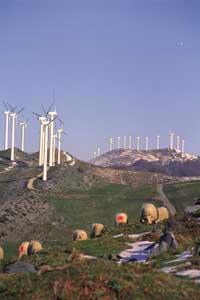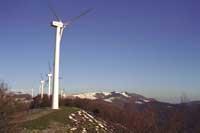Wind energy? Of course! But not so!
What?

A few years ago Iberdrola and the EVE (Ente Vasco de la Energía) constituted the company "Elicos de Euskadi S.A." for the generation and sale of electric power through wind energy in the Autonomous Community of the Basque Country. This company plans to build a wind farm in the Elgea massif.
They want to build an industrial facility that uses wind energy to generate electricity. In a first phase of the Sierra de Elgea it is intended to install 40 wind turbines 60 meters high (a house of 20 floors). Once this is finished, two new phases are being investigated, with a total of 120 wind turbines.
Where?
To carry out this project have been selected the Elgea and Urkilla mountain ranges, which separate the Alto Deba valley from the Llanada Alavesa, affecting the following municipalities: Oñati, Aretxabaleta, Eskoriatza, Barrundia and San Millán. Bear in mind that this place is one of the most extensive freeway spaces in the Autonomous Community of the Basque Country, including the mountains of Elgea, Urkilla and Aizkorri.
If we take and look at a map, we will immediately see its limits:
- To the north, the reservoir of Urkulu, Araotz and Arantzazu.
- To the South the municipalities of Ozeta, Hermua, Larrea, Gordoa... of the Llanada Alavesa.
- To the west the road of the Alto Deba valley to Vitoria and the reservoir of Ulibarri.
- To the east the road of Goierri-Alsasua.
It is observed that it is a portion of land with an area of km2. In March 1995 proceedings were initiated for the declaration of the Aizkorri Natural Park, but the process has been paralyzed recently. Does this have to do with defining the boundaries of the Elgea wind farm?
In the whole of Euskal Herria there are few places with this type of extension and natural value. The Basque Government itself published in 1992 the "Catalogue of Relevant Natural Spaces of the Autonomous Community of the Basque Country". Soon after, another map appeared that collected the sights for the construction of wind farms, all of them more than 800 meters high. These two maps seem the same.
When?
The latest administrative formalities of the project progress and the works can begin at the end of 1998.
Why?

They will give a thousand reasons to believe that this central is necessary, but we have to have clear priorities of each one. Yours is a business, ultimately money, and not promote the use of alternative energies. The amount of energy generated with this type of facilities is very low compared to that consumed in the Autonomous Community of the Basque Country. The excuse is to reduce CO2 emissions, but wind farms only achieve this goal symbolically.
By 2012, 26 wind farms are expected to be built, which will all produce only 4% of electricity consumption, but due to the existence of public subsidies for this type of investment, profits grow.
Why not?
Wind farms will not involve the disappearance of other types of productions (nuclear, thermal, etc. ). If we wanted to supply wind energy to the consumption of Hego Euskal Herria, we would have to make 300 wind farms like Elgea! and as electricity consumption increases every year, every year we would need 20 new wind farms.
Thus it is observed that today, and with this model, wind energy is not a representative energy source, but a tool to meet the growth of electricity demand. The
developers of this project do not want to take into account the damage it will cause. The most important from our point of view are:
- They will enable the industrialization of the mountain, creating new tracks, facilitating human presence, with the negative consequences that this entails.
- It will involve a great physical transformation of the environment.
- The landscape will change radically, as the appliances of this size will look very far.
- It will affect local vultures, water birds that circulate between the reservoirs of Urkulu and Ulibarri, and other types of birds.
- Due to the noise generated by wind turbines, land animals will move away from this medium.
- It will also affect the vegetation of this region.
- One of the most important archaeological areas of the Basque Country (Mugarriluze, Mugarrihaundi, Túmulos de Alabitarte...) will have a strong influence.
Some significant data

Elicos of Euskadi S.A. indicates that the annual production of the Elgea plant will be 66 MkW> h. In Navarra, the Pardon plant announced a production of between 62-65 MkW> h, while in 1997 only 54.4 MkW> h was reached.
But, despite the best predictions, this power plant will cover the electrical needs of 100,000 inhabitants, according to Eolians. To achieve this spectacular number they are based on the data that suits them, that is, on the electricity consumed in homes. Suddenly they have forgotten that people need electricity elsewhere: factories, offices, streets... If we take it into account, the number of people who are going to use the electricity generated in the central Elgea does not reach 9,000.
Wind energy yes
Our position is favorable to clean and renewable energy sources, but the model being developed here is the one we question. Why don't decentralized parks, smaller ones and those located in places used by man, be promoted?
The Basques have always had a great connection with our mountains. Knowing the data we have given so far, is it worth getting a small part of the electricity consumption, industrializing and making disappear the mountains that are almost intact?





